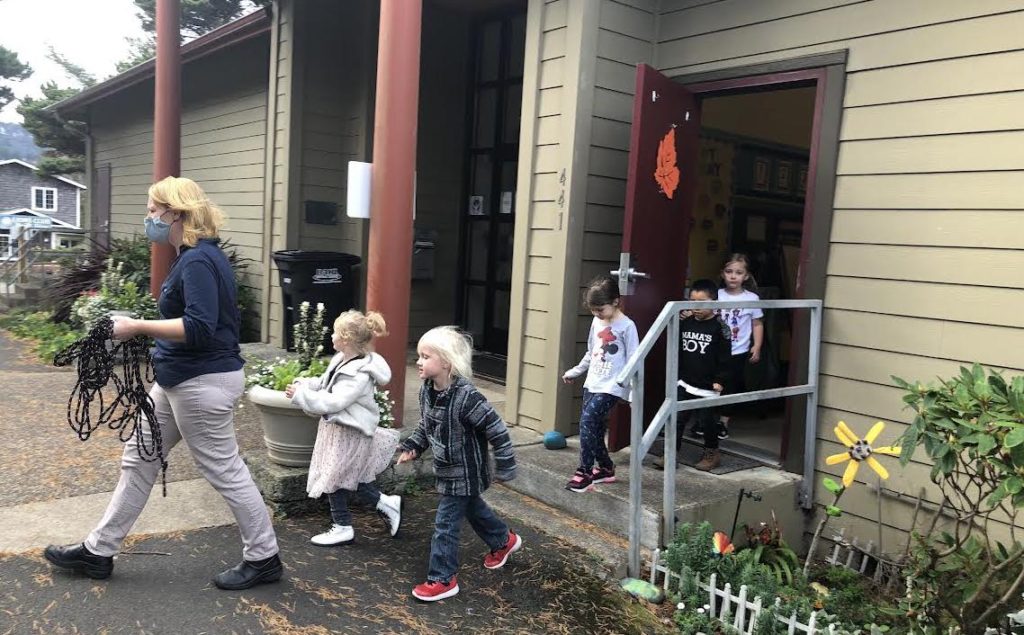
By DANA TIMS/YachatsNews.com
At 10:21 a.m. Thursday, pre-school instructor Jodie Dalby noisily shook a rattle to indicate an earthquake was hitting the Yachats Commons.
Immediately the seven children in the upstairs classroom wiggled out of their chairs and took shelter under their lunch table.
“What do we do, what do we do?” Dalby asked as the kids went through their drill.

After a minute, Dalby and Yachats Youth & Family Activities Program teachers Krissy Pankey and Patricia Hettinger led them out the classroom to safety outside — a practice advised if people are in older buildings should an earthquake strike.
The YYFAP children and staff were among the Lincoln County organizations and individuals who practiced Thursday on what to do in case of a major earthquake.
This year’s edition of the Great Oregon ShakeOut comes just months after a state report predicting that nearly 20,000 Oregonians – including more than 1,000 Lincoln County residents – would likely die if a magnitude 9.0 earthquake and resulting tsunami strike off the Oregon coast.

“So we view this type of training as critically important to getting people prepared and saving lives,” said Virginia “Jenny” Demaris, Lincoln County’s emergency manager. “We believe that a culture of preparedness is the best way to do that.”
International ShakeOut Day, held every year on the third Thursday of October, doesn’t differentiate between earthquakes that occur onshore or offshore, she said. But given the 680-mile-long Cascadia fault line off Oregon’s coast, it makes sense here to focus on a major offshore event.
Training sessions, which began precisely at 10:21 a.m. Thursday, focused on the three things people should do once the intense shaking of a major earthquake begins — drop, cover and hold on.
Dropping to one’s knees protects people from being knocked down, while also allowing them to stay low and crawl to shelter, according to training documents. Covering one’s head and neck with one arm and hand helps protect vital organs. And holding on to the nearest stable object until the shaking stops provides stability until a person can head either for shelter or, in the case of coastal residents, the chance to move to higher ground in anticipation of a subsequent tsunami.
“This is really all about preparedness,” Demaris said. “Now is a great time, for instance, to look around your own house to see where you can reduce the chance of things falling from walls or ensuring you know the fastest way to exit a room.”
The state and local push to take cover received some pushback before the event, with a prominent Oregon State University seismologist urging people who are in older buildings to immediately go outside to avoid being caught in a collapsed building.
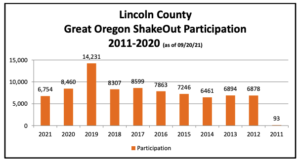
In Oregon, more than 530,000 people signed up to participate in the Great ShakeOut’s training regimen. The number was nearly 25,000 in Lincoln, Clatsop, Coos, Curry and Tillamook counties.
This year’s coastal participation far exceeded the 18,587 people who signed up for last year’s ShakeOut. Demaris attributed that to the intense focus in 2020 of recovering from the deadly wildfires that swept through coastal forests last September.
“First, people were just kind of hunkering down due to Covid last year, then the Echo Mountain Complex Fire hit after Labor Day and all of us were really focused on helping our communities get through all that trauma,” she said. “Really, you almost have to throw those 2020 ShakeOut numbers out the window.”
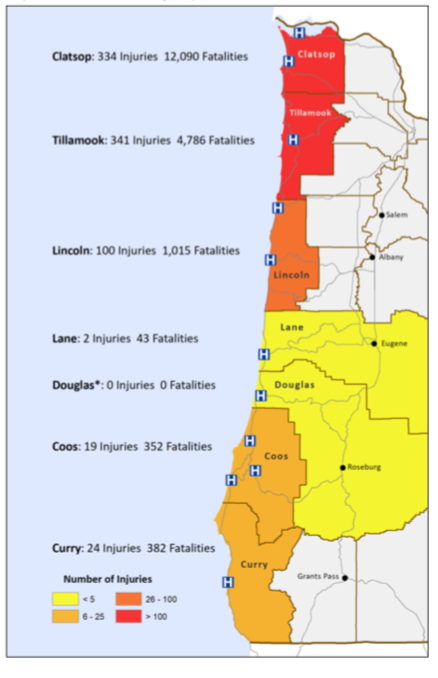
Coastal fatality report
This year’s drill follows the release in May of a state-funded report concluding that tsunami casualties in Oregon would approach 20,000, with most of those ending as fatalities.
“The majority of people who cannot escape the tsunami will die rather than suffer injuries,” said the report, which was commissioned by the Oregon Health Authority.
Death rates are projected to be highest in Clatsop and Tillamook counties, where an estimated 12,090 and 4,786 people, respectively, would not survive.
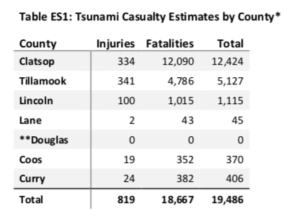
An estimated 1,015 Lincoln County residents are projected to die, with another 100 suffering severe injuries, according to the 32-page document.
In many natural disasters, far more people are likely to be injured than killed, it notes. That equation is flipped when tsunamis hit.
“Unlike most other natural disasters, for tsunamis, the proportion of fatalities is reversed where most victims die rather than only suffer injuries,” it says. “In general, if a person is caught where the tsunami is over six feet deep, then death is likely.”
The methodology for the estimates assumes that a 9.0 earthquake and resulting tsunami strike at 2 a.m. on a summer night, when coastal populations are at their highest.
The remaining coastal counties farther south are less likely to be hit as hard by such an event, according to the document. That’s primarily due to their “lower tsunami exposure both in terms of low-lying vulnerable geography and people at-risk.”
While the Great ShakeOut focuses primarily on earthquake preparedness, Lincoln County’s Demaris said, it also presents a good opportunity for people to be aware that a tsunami will almost certainly follow a strong earthquake.
“If you are in an inundation zone, it’s critical to know how long it will take you to get to safety,” she said. “You’ll be short on time, but the more training and information you have, the better off you and your family will be.”
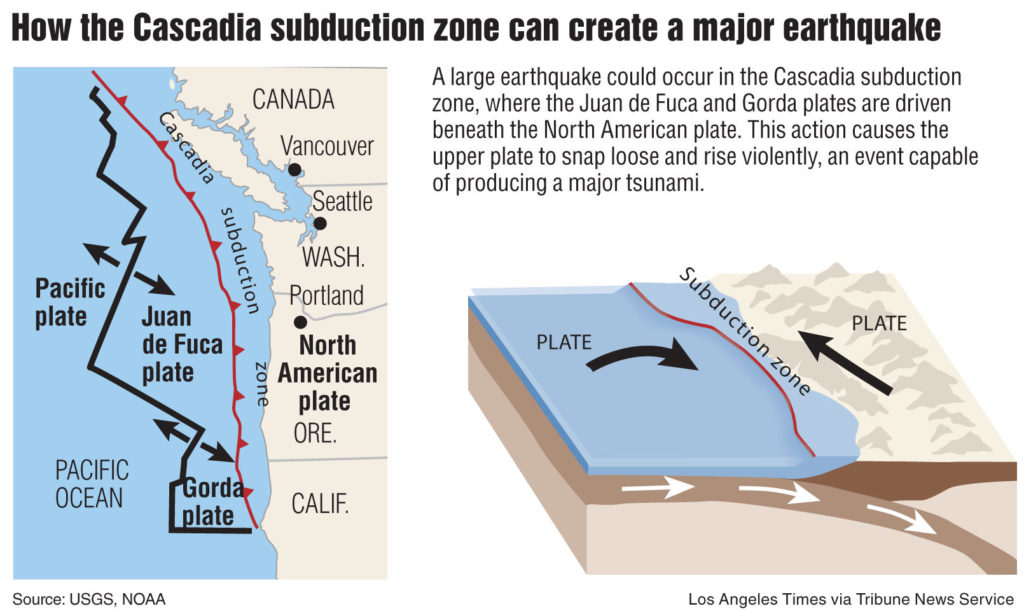
- Quinton Smith of YachatsNews contributed to this report.
- Dana Tims is an Oregon freelance writer who contributes regularly to YachatsNews.com. He can be reached at DanaTims24@gmail.com




















